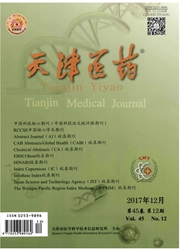

 中文摘要:
中文摘要:
目的探讨可动式椎间盘镜(MMED)下保留后韧带复合体的颈椎管扩大成形术治疗局限性颈椎管狭窄症的效果及可行性。方法天津市天津医院2015年2月—2016年2月收治的局限性颈椎椎管狭窄症患者11例,男6例,女5例,年龄51~77岁,平均(67.4±7.6)岁;狭窄节段包括C3~5者5例,C4~6者4例,C5~7者2例。应用MMED方法对其进行治疗。MMED工作通道可根据操作需要随意倾斜。设计手术方法:透视定位狭窄节段,行后正中切口2.5cm,沿项韧带分离至棘突,沿棘突两侧切断少许肌肉附着点,紧贴棘突一侧插入操作套管,显露目标节段的椎板及椎板间隙,安置手术套管及成像系统,镜下用磨钻在椎板与关节突交界处开槽,磨除骨质后勾起黄韧带,超薄枪钳咬除黄韧带及部分椎板,显露硬膜囊。同法沿棘突另一侧安置通道,开槽减压;双侧侧方椎管减压充分后,棘突及后韧带复合体后移,椎管扩大。记录手术时间、出血量,随访评估疗效。结果手术时间80~120min,平均(100±18)min,术中出血50~120mL,平均(80±20)mL。术后CT示椎管减压充分,棘突后移椎管扩大。患者均未发生神经损伤等严重并发症,术后症状不同程度改善。术后随访6~18个月,X线示颈椎序列良好,功能障碍指数(ODI)由术前42.2±16.3降至6.2±4.3,日本骨科学会(JOA)评分由术前8.2±3.3改善至末次随访15.1±4.2,根据改善率([术后JOA-术前JOA)(/17-术前JOA)]优5例,良5例,有效1例。结论MMED下保留后韧带复合体的颈椎管扩大成形术治疗局限性颈椎管狭窄症可达到充分减压并减少手术创伤的效果。
 英文摘要:
英文摘要:
Objective To provide a minimally invasive surgical treatment using mobile microendoscopy(mobile MED)for limited cervical spine canal stenosis.Methods Eleven patients were collected from February2015to February2016in Tianjin Hospital,including6males and5females,aged51-77years,mean(67.4±7.6)years.Clinical treatment was performed on11patients of limited cervical spinal stenosis.The levels of stenosis included C3-5in5cases,C4-6in4cases,C5-7in2cases.The working channel of mobile MED(MMED)can be tilted according to the need of operation.The design of surgical methods:the levels of stenosis were located with fluroscopy,through a posterior median2.5cm incision,the nachal ligaments was separated and the spinous process was reached.After a little dissection of paraspinal mascle,theworking canal was inserted along the spinous process,and the target lamina was exposed.With MMED,the partial laminectomy was performed along the junction groove of lamina and articular process with high-speed burr,and flavum was exposed and resected with ultra-thin Kerisson,and the dural sac was well exposed.Then the working canal was inserted onthe contralateral side along the spinous process,and the decompression was performed with the same method.After bilateraldirect decompression,the spinous process and posterior ligament complex shift posteriorly with enlargement of spinal canal.The operation time and blood loss were recorded and the efficacy was followed-up.Results There was no serious complications such as neurological injury.The operation time ranged80-120min,with an average of(100±18)min.The intraoperative blood loss ranged(50-120)mL,with an average of(80±20)mL.Postoperative CT showed sufficient decompression and enlargement of the canal with the posterior shift of the spinous process and posterior ligament complex.The patients were followed up for6-18months.The alignment of cervical spine was well preserved on X-ray.The ODIdecreased from42.2±16.3preoperatively to6.2±4.3.The JOA score improved from8.2±3.3preoperatively to15.1±4.2
 同期刊论文项目
同期刊论文项目
 同项目期刊论文
同项目期刊论文
 期刊信息
期刊信息
